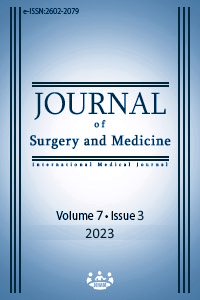Placenta accreta spectrum: Is placental invasion real?
Placenta accreta spectrum
Keywords:
adherent placenta, cesarean hysterectomy, placenta accretaAbstract
Background/Aim: The description of placenta accreta spectrum disorder (PAS) has undergone significant changes. However, its association with obstetric morbidity and mortality has become even more important. Therefore, we aimed to assess the histopathologic evaluation of PAS patients who underwent a hysterectomy.
Methods: We conducted a retrospective study of all pathology reports from patients with peripartum hysterectomies at Sanliurfa Training and Research Hospital diagnosed with PAS. The study included 45 patients with a cesarean hysterectomy due to a preoperative placenta accreta spectrum disorder diagnosis. Hysterectomy specimens were evaluated based on placental invasion and myometrial defect at the site of the placenta.
Results: Out of 45 patients diagnosed with placenta accreta spectrum disorder who underwent a hysterectomy, only 17 (37.8%) had a histological diagnosis supporting the placental invasion. The histological diagnosis was consistent in 20 (44.4%) patients, indicating that the placenta protruded from a uterine wall defect without placental invasion. In eighth (17.8%) patients, the histopathological diagnosis was consistent with a histologically normal placenta.
Conclusion: The primary pathology of the disorder is variable, and the main issue is the association of the placenta with defective myometrium. Although a more alarming definition, such as invasion, should be avoided, PAS should not be underestimated due to its high mortality.
Downloads
References
Jauniaux E, Ayres-de-Campos D, Diagnosis FPA, Management Expert Consensus P. FIGO consensus guidelines on placenta accreta spectrum disorders: Introduction. Int J Gynaecol Obstet. 2018;140(3):261-4. Epub 2018/02/07. doi: 10.1002/ijgo.12406. PubMed PMID: 29405322. DOI: https://doi.org/10.1002/ijgo.12406
Jauniaux E, Alfirevic Z, Bhide AG, Belfort MA, Burton GJ, Collins SL, et al. Placenta Praevia and Placenta Accreta: Diagnosis and Management: Green-top Guideline No. 27a. BJOG. 2019;126(1):e1-e48. Epub 2018/09/28. doi: 10.1111/1471-0528.15306. PubMed PMID: 30260097. DOI: https://doi.org/10.1111/1471-0528.15306
American College of O, Gynecologists, Society for Maternal-Fetal M. Obstetric Care Consensus No. 7: Placenta Accreta Spectrum. Obstet Gynecol. 2018;132(6):e259-e75. Epub 2018/11/22. doi: 10.1097/AOG.0000000000002983. PubMed PMID: 30461695. DOI: https://doi.org/10.1097/AOG.0000000000002983
Carusi DA FK, Lyell DJ, Perlman NC, Aalipour S, Einerson BD, et al Placenta accreta spectrum without placenta previa. Obstetrics & Gynecology.2020;136(3):458-65. DOI: https://doi.org/10.1097/AOG.0000000000003970
Einerson BD, Comstock J, Silver RM, Branch DW, Woodward PJ, Kennedy A. Placenta Accreta Spectrum Disorder: Uterine Dehiscence, Not Placental Invasion. Obstet Gynecol. 2020;135(5):1104-11. Epub 2020/04/14. doi: 10.1097/AOG.0000000000003793. PubMed PMID: 32282597. DOI: https://doi.org/10.1097/AOG.0000000000003793
Jauniaux E, Bhide A. Prenatal ultrasound diagnosis and outcome of placenta previa accreta after cesarean delivery: a systematic review and meta-analysis. Am J Obstet Gynecol. 2017;217(1):27-36. Epub 2017/03/08. doi: 10.1016/j.ajog.2017.02.050. PubMed PMID: 28268196. DOI: https://doi.org/10.1016/j.ajog.2017.02.050
Kaufmann P BG. Anatomy and genesis of the placenta The physiology of reproduction. 1994;1:441-84.
Tantbirojn P, Crum CP, Parast MM. Pathophysiology of placenta creta: the role of decidua and extravillous trophoblast. Placenta. 2008;29(7):639-45. Epub 2008/06/03. doi: 10.1016/j.placenta.2008.04.008. PubMed PMID: 18514815. DOI: https://doi.org/10.1016/j.placenta.2008.04.008
Strickland S, Richards WG. Invasion of the trophoblasts. Cell. 1992;71(3):355-7. Epub 1992/10/30. doi: 10.1016/0092-8674(92)90503-5. PubMed PMID: 1423599. DOI: https://doi.org/10.1016/0092-8674(92)90503-5
Wehrum MJ, Buhimschi IA, Salafia C, Thung S, Bahtiyar MO, Werner EF, et al. Accreta complicating complete placenta previa is characterized by reduced systemic levels of vascular endothelial growth factor and by epithelial-to-mesenchymal transition of the invasive trophoblast. Am J Obstet Gynecol. 2011;204(5):411:e1-e11. Epub 2011/02/15. doi: 10.1016/j.ajog.2010.12.027. PubMed PMID: 21316642; PubMed Central PMCID: PMCPMC3136625. DOI: https://doi.org/10.1016/j.ajog.2010.12.027
Tseng JJ, Chou MM. Differential expression of growth-, angiogenesis- and invasion-related factors in the development of placenta accreta. Taiwan J Obstet Gynecol. 2006;45(2):100-6. Epub 2007/01/02. doi: 10.1016/S1028-4559(09)60205-9. PubMed PMID: 17197348. DOI: https://doi.org/10.1016/S1028-4559(09)60205-9
Earl U, Bulmer JN, Briones A. Placenta accreta: an immunohistological study of trophoblast populations. Placenta. 1987;8(3):273-82. Epub 1987/05/01. doi: 10.1016/0143-4004(87)90051-8. PubMed PMID: 2443908. DOI: https://doi.org/10.1016/0143-4004(87)90051-8
Lunghi L, Ferretti ME, Medici S, Biondi C, Vesce F. Control of human trophoblast function. Reprod Biol Endocrinol. 2007;5:6. Epub 2007/02/10. doi: 10.1186/1477-7827-5-6. PubMed PMID: 17288592; PubMed Central PMCID: PMCPMC1800852. DOI: https://doi.org/10.1186/1477-7827-5-6
Timor-Tritsch IE, Monteagudo A, Cali G, Vintzileos A, Viscarello R, Al-Khan A, et al. Cesarean scar pregnancy is a precursor of morbidly adherent placenta. Ultrasound Obstet Gynecol. 2014;44(3):346-53. Epub 2014/06/04. doi: 10.1002/uog.13426. PubMed PMID: 24890256. DOI: https://doi.org/10.1002/uog.13426
Downloads
- 325 560
Published
Issue
Section
How to Cite
License
Copyright (c) 2023 Alev Esercan , Emre Ekmekci , Ferhat Coskun
This work is licensed under a Creative Commons Attribution-NonCommercial-NoDerivatives 4.0 International License.
















